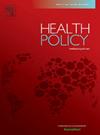Quantitative trend analysis of well-established use mutual recognition and decentralised products indicates codified disharmonisation in the European Economic Area
IF 3.6
3区 医学
Q1 HEALTH CARE SCIENCES & SERVICES
引用次数: 0
Abstract
The growing number of well-established use (WEU) applications was reported by the Coordination Group for Mutual Recognition and Decentralised Procedures – Human (CMDh). The procedures from the CMDh annual statistics and products from the Mutual Recognition Information Product Index were analysed between 2006 and 2023. Drop-out and CMDh referral rates were determined, and the Anatomical Therapeutic Chemical codes for WEU products were subjected to trend analysis. The Summaries of Product Characteristics (SmPC) of active substances with a growing interest were scored to determine the level of disharmonisation in the most commonly authorised strength and pharmaceutical forms. The rise in the relative number of WEU applications has been confirmed. The reasons for heightened interest in WEU applications could be explained by (i) the reliable legal basis it has transformed into, (ii) the flexibility, (iii) the incentive system awarding protection. Products containing 3 mg melatonin and 25,000 IU colecaliferol in solid oral forms were the most sought-after products in recent years. An analysis of the SmPCs revealed a significant degree of disharmonisation in the clinical particulars, and it also shed light on intra- and inter- Reference Member State (RMS) variance in the decision making. The current European medicine approval system is not suited to effectively handle this ever-increasing use of one of the most resource intensive legal bases due to the high level of disharmonisation that has been overlooked for years. Consequently, a change in the current application compilation and assessment practices might be beneficial to ensure patient safety and therapy success.

对既定用途相互认可和分散产品的定量趋势分析表明,欧洲经济区的法规不协调
互认和去中心化程序-人类协调小组(CMDh)报告了越来越多的既定用途(WEU)申请。分析了2006年至2023年间CMDh年度统计数据的程序和互认信息产品指数的产品。确定退出率和CMDh转诊率,并对WEU产品的解剖治疗化学代码进行趋势分析。对越来越受关注的原料药的产品特性摘要(SmPC)进行评分,以确定最常用的批准剂量和药物形式的不协调程度。WEU申请的相对数量的增加已经得到证实。人们对自由贸易联盟申请的兴趣增加的原因可以解释为:(i)它已转变为可靠的法律基础;(ii)灵活性;(iii)奖励制度给予保护。含有3毫克褪黑素和25000国际单位的固体口服皂角醇的产品是近年来最受欢迎的产品。对smpc的分析揭示了临床细节的显著程度的不协调,它也揭示了参考成员国(RMS)内部和内部决策的差异。由于多年来被忽视的高度不协调,目前的欧洲药品审批系统不适合有效地处理这种不断增加的资源密集型法律基础之一的使用。因此,改变当前的应用程序编译和评估实践可能有利于确保患者安全和治疗成功。
本文章由计算机程序翻译,如有差异,请以英文原文为准。
求助全文
约1分钟内获得全文
求助全文
来源期刊

Health Policy
医学-卫生保健
CiteScore
6.40
自引率
6.10%
发文量
157
审稿时长
3-8 weeks
期刊介绍:
Health Policy is intended to be a vehicle for the exploration and discussion of health policy and health system issues and is aimed in particular at enhancing communication between health policy and system researchers, legislators, decision-makers and professionals concerned with developing, implementing, and analysing health policy, health systems and health care reforms, primarily in high-income countries outside the U.S.A.
 求助内容:
求助内容: 应助结果提醒方式:
应助结果提醒方式:


